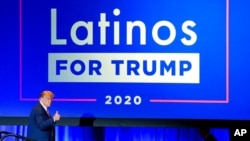In his 1796 farewell address, George Washington cautioned the citizens of the United States against forming political parties, which he claimed could undermine national unity, stoke division and even foment insurrections. Despite this advice, much of the country’s history has been shaped by party rivalry, and in the modern era, the Democratic and Republican parties are considered the only viable electoral options at the national level.
However, what each party stands for and which people it represents has changed drastically over time. Once a primarily Southern party that defended the interests of slaveholders, the Democratic Party shifted over the decades to a become a vehicle for labor and civil rights movements. The Republican Party, meanwhile, transformed from a modernizing abolitionist party to one favored by conservative and rural voters in the South. Today, the demographic coalitions that make up each party appear to be shifting yet again, with major implications for the country’s future.
Political coalitions in the 2016 presidential election
While the Democratic Party was long seen as the party of labor unions and the working class, it began to lose blue-collar white voters in the 1990s following Ronald Reagan’s presidency. Barack Obama successfully compensated for this loss in 2008 and 2012 by bringing together African Americans, Latinos and other racial and religious minorities, as well as progressives, women and younger voters.
Obama’s campaign also saw college graduates, previously correlated with higher-income Republican voters, shift toward the Democratic Party in a trend that continues today.
Hillary Clinton sought to maintain this Obama coalition in her 2016 campaign against Donald Trump by embracing progressive policies and stressing racial and gender equality. But Obama’s victory also relied on white working-class voters in northern states such as Michigan, Wisconsin and Pennsylvania, to whom he appealed as an outsider candidate.
Trump successfully peeled away large numbers of these voters with his promises of restoring American industry and rejecting mainstream Republican defenses of free trade. And despite what was often seen as racially divisive campaign rhetoric, Trump outperformed previous Republican candidates among nonwhite voters without college degrees.
Clinton picked up support among affluent and married voters in Republican-leaning suburbs, but many of these gains were concentrated in non-battleground states. At the same time, the former first lady could not match Obama in commanding the same high levels of turnout and enthusiasm among Black and young voters. And despite Clinton’s emphasis on the historic nature of her candidacy, white women voters preferred Trump by a small margin. In the end, the Obama coalition proved to be unreliable without the Democratic Party’s traditional blue-collar foundation.
Political coalitions in the 2020 presidential election
Having unsuccessfully run for president since the 1980s, Joe Biden emerged as an unlikely front-runner in a crowded primary field.
Despite being seen as a conservative choice, Biden quickly secured the support of more progressive candidates once he was nominated and adopted some of their positions in his platform. Biden’s bipartisan record and blue-collar background appealed to older voters and suburban moderates, as well as independents and working-class voters. And harnessing Barack Obama’s legacy as his former vice president allowed Biden to resurrect the Obama coalition in a way that Hillary Clinton could not.
While Biden may not have been the first choice for many progressive, young and minority voters, the polarizing and controversial nature of Donald Trump’s presidency and fear of his reelection was enough to secure their support.
The COVID-19 outbreak also proved to be a factor, with Biden a clear favorite among voters who considered the pandemic to be a major concern — especially in battleground states, where cases spiked before the election.
Biden’s appeal as a candidate managed to stem some of Trump’s momentum among working-class white voters, where the Republican margin narrowed from 36% in 2016 to 32% in 2020.
But Trump improved his standing with several other voter demographics, some of them unexpected. The Republican candidate solidified his support among white evangelical voters, who were initially divided over his character and personal conduct before coalescing behind him in 2016.
Trump’s support among women also increased by about five percentage points, narrowing the gender gap.
Most surprisingly, Trump made inroads with Latino voters in Southern states, despite his anti-immigration rhetoric. His appeal was particularly notable among Latino men, who preferred Biden by a significantly smaller margin than Latino women. The result was that despite his loss, Trump attracted a more diverse coalition than any Republican candidate in decades.
Political coalitions in the 2024 presidential election
The 2024 presidential election will pit presumptive Democratic nominee Joe Biden’s reelection campaign against presumptive Republican nominee Donald Trump, despite the legal challenges facing Trump’s candidacy.
Biden is expected to try to revive the coalition from his previous run in 2020, with messaging focused on reproductive rights, preventing Trump from returning to office and protecting American democracy from the threat of what he calls "MAGA extremism.”
Such appeals resonate strongest with college-educated voters, who have now emerged as the core constituency of the Democratic Party. In fact, education has now fully eclipsed income level as one of the strongest indicators of partisan affiliation.
But although college graduates now make up 41% of the electorate — far more than in previous decades — they are also overwhelmingly white.
The other large bloc that Democrats must rely on are nonwhite voters without college degrees — a group with markedly different economic interests and social views. It is among these voters that the Republicans stand to gain support by emphasizing cultural conservatism, anti-elitism and economic nationalism.
Over the years, analysts have predicted that demographic trends toward a majority- nonwhite population would doom the Republican Party in the long term. However, the dynamics of the Trump coalition and the rise of Republican leaders like Nikki Haley and support for independent candidates suggest that the Democratic Party may no longer be able to take minority voters for granted.
Both parties will face unique challenges with key parts of their coalitions. The Biden administration’s support of Israel in its war against Hamas in Gaza, which has killed more than 35,000 Palestinians, according to Gaza health authorities, has alienated Arab and Muslim communities and younger Black and Hispanic voters.
Meanwhile, Trump faces multiple criminal cases. And although he has dismissed the charges as partisan, many Republicans say they won’t vote for him if he is convicted.















